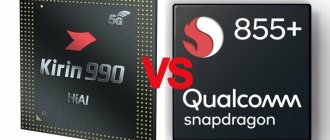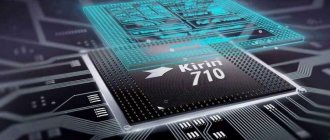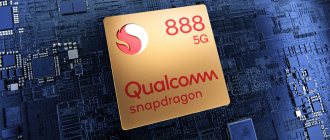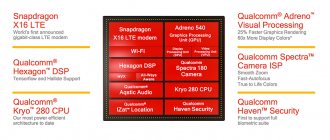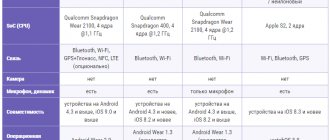At the IFA exhibition in Berlin, Huawei brought the mid-range smartphone Mate 20 Lite and the Kirin 980 processor. The phone aroused great interest among a wide target audience, while the new processor attracted increased attention from people interested in smart technology. This is no wonder, because HiSilicon Kirin 980 was the first chip to be produced using the thinnest 7 nm manufacturing process to date.
As always happens, at the presentation the company’s CEO talked a lot about what titanic work led to the creation of an innovative single-chip platform, and how confidently the new chip is ahead of its competitors.
According to Richard Yu, more than a thousand company employees worked on the Kirin 980 processor. The result is a chipset that is much more efficient and faster than the Snapdragon 845 and Apple A11 Bionic. True, he forgot to mention that the comparison subjects were presented last year. Very soon new, much more powerful chips produced according to the standards of the same 7 nm lithography will enter the arena.
Main features of the new Kirin 980 processor
The processor houses 6.9 billion transistors, which allows for significant improvements in performance and energy efficiency compared to previous generation devices.
The processor was the first to use cores based on ARM Cortex-A76 with a dominant clock speed of up to 2.6 GHz. The Kirin CPU subsystem and flexible scheduling engine designs are optimized to achieve optimal energy efficiency with high processing power.
Kirin 980 was also the first commercial processor with Mali-G76 graphics module. Thanks to optimization technology and reduced power consumption, Mali-G76 allows users to play demanding multiplayer video games comfortably.
Kirin 980 supports the world's fastest RAM LPDDR4X, which operates at frequencies up to 2133 MHz and is equipped with a dual neural module. Dual NPU provides high performance for processing AI tasks and offers advanced support for intelligent applications.
Another feature of the Kirin 980 is support for the LTE Cat.21 communication standard , which allows you to maintain consistently high data transfer rates in the most difficult scenarios and environmental conditions. This standard provides record download speeds of up to 1.4 Gbps.
Kirin 980 also uses Huawei's ISP 4.0 image processing technology , which has 46% higher pixel throughput, allowing it to support more cameras while significantly reducing noise and improving color reproduction quality. All these features allow users to capture clear photos and smooth videos in almost any environment. The HiAI ecosystem offers advanced capabilities for developing intelligent applications and a convenient environment for developers.
HiSilicon Kirin 980: characteristics in one line
In the material about HiSilicon Kirin 980, we cannot do without comparing the new processor with its competitors, including the Kirin 970 and Snapdragon 845, but we need to start the conversation with the technical characteristics. In order not to immediately complicate the article with details, we first list the main specifications of the new flagship chip in one line format:
- Technological process: 7 nanometers.
- Architecture: 4 Cortex-A76 cores + 4 Cortex-A55 cores.
- Graphics adapter: Mali-G76 MP10 GPU.
- RAM: LPDDR4x, 2133 MHz.
- Double neural unit NPU.
- Dual ISP image processing co-processor.
- LTE Cat.21 modem: download speed up to 1.4 Gbps.
Next, we will take a closer look at the technical details and simultaneously compare the Kirin 980 processor with its competitors. Note that all comparisons are based on figures announced at the presentation by a Huawei representative. Nobody knows yet how fast the first smartphones on Kirin 980 (Huawei Mate 20 and Mate 20 Pro) will be.
7 nanometer process technology
The transition to a 7 nm manufacturing process made it possible to reduce the size of one transistor and, accordingly, increase the total number of computing units. The Kirin 980 processor contained 6.9 billion transistors per 1 cm2, which is 1.4 billion more than the Kirin 970. You can’t even compare it with the Kirin 950, there were only 3 billion transistors per 1 cm2.
Obviously, the more transistors, the more operations the central processor performs per clock cycle, and the higher the overall speed of its operation. The temperature under load and energy consumption do not increase, but even decrease. All thanks to the finest technological process.
According to company representatives, Huawei Kirin 980 is 20% . Energy consumption will be reduced by 40% .
The above are general figures. If we talk about individual components of the computing process, the advantage here will be even more impressive.
Kirin 980 architecture: 8 cores, three clusters, Cortex-A76 cores
The engineers of the Chinese company proposed a somewhat unusual division of the central processor cores into three clusters. Previously, MediaTek used a somewhat similar three-cluster system, but it did not become very popular.
In the Kirin 980 processor, the most powerful cluster is represented by two Cortex-A76 operating at 2.6 GHz . The medium-power cluster is represented by two cores of the same type, limited to a frequency of 1.92 GHz . An efficient cluster designed to solve simple tasks and save battery power, built on Cortex-A55 cores; These cores operate at a clock frequency of 1.8 GHz .
The Kirin 980 processor has three core clusters: 2x Cortex-A76, 2.6 GHz + 2x Cortex-A76, 1.92 GHz + 4x Cortex-A55, 1.8 GHz.
In principle, the central processor architecture is built using DinamIQ technology, but the developers came up with their own name for it - big.middle.LITTLE. Due to the super powerful Cortex-A76 cores (ARM introduced them only 3 months ago), the Kirin 980 processor is 75% faster in terms of the speed of one CPU core compared to the Kirin 970. Energy consumption is 58% lower.
is 75% faster terms of single CPU core speed compared to the Kirin 970. Energy consumption is 58% lower.
Routine tasks are entirely solved by Cortex-A55 cores. They are tasked with playing music, playing videos, and ensuring smooth navigation through the operating system. Medium Cortex-A76 cores are connected when running the camera application, browser and relatively heavy applications. Powerful Cortex-A76 cores sit idle most of the time; They turn on only in games and when launching the gallery.
Kirin 980 vs Snapdragon 845. Narrow specialization of computing units helps reduce energy consumption and increase operating speed.
In practice, increased performance should result in faster application startup times. So, Facebook will open in 1 second, WhatsApp in 0.7 seconds. You can compare the launch speed of various applications on the Kirin 980 and Snapdragon 845 in the table. Kirin 980 vs Snapdragon 845: application launch speed
| HiSilicon Kirin 980 | Snapdragon 845 | |
| 1 second | 1.3 seconds | |
| 0.6 seconds | 0.7 seconds | |
| 0.7 seconds | 0.8 seconds | |
| YouTube | 0.8 seconds | 1.0 second |
| 1.5 seconds | 1.6 seconds |
RAM: LPDDR4x, 2133 MHz
Applications will launch faster not only due to better architecture. LPDDR4x RAM operating at 2133 MHz . For comparison, the Snapdragon 845 RAM frequency is limited to 1866 MHz.
Due to the increase in frequency, the RAM bandwidth increased by 20%, to 23 GB/sec. Latency decreased by 22% to 138 nanoseconds.
Mali-G76 graphics adapter
For a long time there were rumors that the Kirin 980 would receive last year's Mali-G72 graphics accelerator, but with 24 cores instead of 12. Fortunately, this did not happen. The processor is equipped with a top-end graphics card from ARM Mali-G76 MP10 GPU, which was introduced this summer along with Cortex-A76 cores.
The Mali-G76 MP10 GPU graphics accelerator operates at a clock frequency of 720 megahertz, but due to its more advanced architecture it literally smashes its predecessor to smithereens. According to a company spokesperson, graphics processing power has increased by 46%, while power consumption has decreased by 178%. This is when compared with Kirin 970.
Mali-G76 MP10 (Kirin 980) is 46% faster and 178% more efficient than Mali-G72 MP12 GPU (Kirin 970).
Kirin 980 vs Snapdragon 845. But even Huawei representatives understand and admit that comparing the graphics potential of the Kirin 980 with the Kirin 970 gives little. If we compare the Kirin 980, it’s with the Snapdragon 845, which is equipped with today’s standard Adreno 630 graphics.
For comparison, they ran NBA 2K18 on test platforms and got results that put the Kirin 980 in a very favorable light. The average frame rate on the Kirin 980 was 59.3 fps , while on the Snapdragon 845 the average frame rate stopped at 48.6 fps . Moreover, in the smartphone on the S845 there were drops in FPS up to 20 frames per second (and this is already critical), while on the K980 there were no such drops in frame rate.
Compared to the Snapdragon 845, the Kirin 980 is 22% faster in games and 32% more efficient.
Kirin 980 is ahead of its competitor in terms of efficiency. The energy consumption of the new Huawei processor was 43.7 milliwatts per frame , while the Snapdragon 845 spent 64.5 mW . How can one not recall the recently introduced GPU Turbo mode, which does not increase the framerate, but rather improves the efficiency of Kirin processors when working with graphics!
Co-processors: dual NPU and dual IPS
Of course, the Kirin 980 presentation did not ignore the topic of machine learning and artificial intelligence, the achievements in which Huawei developers can rightfully be proud of. The new single-chip platform received a double neural unit (Neural Processing Unit, NPU) to solve problems requiring artificial intelligence. Thanks to the double block, the image recognition speed has increased by 220%. Overall, the new processor performs intelligent tasks twice as fast as the Snapdragon 845 and three times faster than the Apple A11 Bionic.
Dual IPS for processing images coming from smartphone cameras will also make a feasible contribution to the performance, quality of work and autonomy of future new products. Thanks to the improved ISP, the speed of the camera application will increase by 46% (compared to Kirin 970), and power consumption will decrease by 23%.
Kirin 980 sets the direction for the industry
The production technology of mobile processors directly affects their performance and energy consumption. Today, the most common manufacturing process is 10 nm, and the Kirin 980 was the world's first commercial chip manufactured using the latest 7 nm process developed by TSMC. The new technology increases transistor density by 1.6 times, allowing for an increase in integrated circuit performance by 20% compared to the 10nm process. At the same time, the energy efficiency of the new chip has increased by 40%.
Improvements in processor production technology go hand in hand with the consistent evolution of chip designs. Physically, a silicon semiconductor can be reduced to 7 nm before electrons begin to flow uncontrollably from one gate to another. To get close to this 7nm limit, Kirin 980 had to overcome the limitations of existing semiconductor technology, as well as the 3D resistance and capacitance of transistors.
Huawei developers began basic research into the new 7nm process three years ago. To effectively solve all the problems of mass production, the industry's best specialists in integrated circuits and system design were assembled. Featuring a heterogeneous converged system architecture and optimized CPU, GPU, NPU, ISP and DDR, Kirin 980 contains 6.9 billion transistors in an area of less than 1 cm2. Powerful CPU, GPU, DDR, smart NPU, high-quality ISP and fast modem provide the processor with high energy efficiency.
To ensure smooth operation under various modes and usage conditions, the first 7nm Kirin 980 chipset went through a variety of tests aimed at verifying performance and power efficiency. A comprehensive check of all components provides the most reliable guarantees of stability and comfort for mobile device users.
IFA 2022: how does Huawei Kirin 980 stack up against Snapdragon 845?
Huawei has not recently announced new smartphones at major international exhibitions, preferring to do so at its own events. This happened this time too: the main novelty of the Chinese company was the Kirin 980 processor. According to the head of Huawei Consumer Business Group, Richard Yu, the Kirin 980 can proudly bear the title of the world’s first product on several counts:
- mobile chipset made using a 7nm process technology;
- processor with Cortex-A76 cores;
- chip with two neural network modules;
- processor with Mali-G76 graphics;
- chipset with built-in Cat.21 modem and data transfer speeds up to 1.4 Gbit/s;
- processor with support for RAM LPDDR4X 2133 MHz.
The transition to the 7nm process technology increased productivity by 20%, improved energy savings by as much as 40%, and the transistor density increased by 1.6 times. Kirin 980 contains 6.9 billion transistors. For comparison, the Kirin 970 had 5.5 billion, and the Kirin 950 had 3 billion.
The transition to the Cortex-A76 cores, introduced three months ago, increased the performance of a single core by up to 75%, and energy efficiency increased by 58%. All this allowed the Kirin 980 to beat its main competitor, the Qualcomm Snapdragon 845, in synthetic tests like GeekBench.
Kirin 980 has a new scheme for using cores in its composition: if previously there was a big.LITTLE scheme, now it is big+middle+little. Two Cortex-A76 cores in the processor operate at a frequency of 2.6 GHz, two more of the same cores have lower frequencies - 1.92 GHz - and act as those very middle cores. Finally, four energy-efficient Cortex-A55 cores operate at 1.8 GHz.
This scheme, according to the company, allows you to efficiently load certain cores depending on the current load. For example, one small core can handle playing music in the player, while smooth operation of Facebook requires the resources of three small and one medium core. When running resource-intensive 3D games, of course, all processor cores are used at once. According to the table shown at the presentation, high-performance cores are not loaded at all during typical tasks on the phone: calls, working with social networks, navigation, listening to music, using the camera, surfing the Internet. Only viewing a gallery of images uses one high-frequency Cortex-A76 core. This resource management scheme should have a positive effect on the battery life of the device.
By using Kirin 980 on smartphones, the time required to launch applications will be reduced. For example, Facebook will load in 1 second exactly, while on devices with Snapdragon 845 it takes 1.3 seconds. The difference may be small, but when you launch various applications hundreds of times a day, even tenths of a second of delay can be annoying.
Huawei also talked a little about the graphics subsystem. The Kirin 980 uses the Mali-G76 GPU, which is 46% faster than the Mali-G72 present in the Kirin 970, and the increase in energy efficiency is even expressed in three digits: 178%. Huawei decided to demonstrate the power of graphics with the help of the game NBA 2K18, launched simultaneously on two devices with two different processors: Kirin 980 and Snapdragon 845. On the first, the average FPS was 59.3, on the second - only 48.5. At the same time, on a smartphone with a Qualcomm processor, drops of up to 20–30 FPS were observed, and this already noticeably affects the gameplay. At the same time, the device with Kirin 980 spent 43.7 mW of energy per frame versus 64.5 mW for its competitor.
Kirin 980 can work with LPDDR4X 2133 MHz memory, which gives increased bandwidth to 23.1 GB/s and decreased latency to 138 ns. Both indicators are noticeably better than the Snapdragon 845.
Huawei claims that the Kirin 980 has support for 4.5G LTE networks: the built-in Cat.21 modem allows theoretical download speeds of up to 1.4 Gbps. The download performance via Wi-Fi networks is also okay: up to 1.7 Gbit/s - according to the Chinese, no other smartphone can do this faster. Although the Kirin 980 does not have built-in support for 5G networks, paired with the Balong 5000 5G modem, it will be possible to create smartphones that support next-generation cellular networks.
The advantages of the Kirin 980 over its predecessor (Kirin 970), as well as over its main competitor (Snapdragon 845), are clearly demonstrated by the following slides:
On paper, the 980 looks very strong, but the real test is ahead of it: there are a couple of months left before the release of Qualcomm Snapdragon 855. The first device based on Kirin 980 will be the flagship smartphone Mate 20 Pro, which will be announced on October 16 in London.
In the meantime, it is not presented, Huawei decided to remind about its current leader - P20 Pro. The company has expanded the range of color options for the smartphone by adding a couple of new colors: pearl and another gradient, which is very similar to the twilight color already on the market. For those who like something unusual, the company has offered smartphones with a leather “back” - black and brown options are available. It is curious that such devices will come with 8 GB of RAM and 256 GB of flash memory and cost 100 euros more.
The announcement of a smart speaker called AI Cube was quite unexpected. Unlike competitors' solutions, the Chinese company's product is also a 4G router. In appearance, the device resembles Google smart speakers, but Amazon Alexa is responsible for the intellectual capabilities of Huawei AI Cube.
Huawei did not mention any timeframe for the product's release to the market or the estimated cost of the speaker - this may indicate that the product has not yet been completed.
Although the announcement of new smartphones did not happen at the official presentation of Huawei, it was at the IFA exhibition that the first representative of the Mate 20 series was declassified. We are talking about a mid-range device called Mate 20 Lite. The smartphone is equipped with a 6.3-inch FHD+ display (1080 × 2340 resolution) with a characteristic “notch” on top. The device is based on a fairly simple Kirin 710 chip, as well as 4 GB of RAM and 64 GB of flash memory.
Pleased with the presence of a 3.5 mm headphone jack and a separate slot for microSD cards, with which you can expand the space by another 256 GB. On the back of the device there is a fingerprint scanner, as well as a pair of cameras: the main one boasts a 20-megapixel sensor, a lens with an f/1.8 aperture and phase detection autofocus. An additional 2-megapixel camera is used for various effects such as background blur, scene recognition using AI or HDR Pro. The battery capacity is 3750 mAh, dimensions are 158.3 × 75.3 × 7.6 mm with a weight of 172 grams.
High energy efficiency: CPU and Mali-G76
We use smartphones almost constantly, so we expect them to be smooth, responsive, and responsive. It is not surprising that the main requirement for new mobile device processors is increased performance.
Kirin 980 became the world's first mobile processor built on Cortex-A76 cores. Compared to the previous generation, Cortex-A76 cores have 75% higher performance and 58% higher power efficiency. In addition, the Kirin processor's CPU subsystem was designed based on the previous generation multi-core architecture.
In addition to adapting and optimizing the terminal services in the CPU core, the scheduling algorithm and CPU bus have been carefully designed to meet the high expectations and requirements of users for performance and battery life.
By the way, the first smartphone that runs on the Kirin 980 processor was Huawei Mate 20 Pro - review of the model.
The CPU subsystem of the Kirin processor uses an intelligent flexible scheduling mechanism, forming a 3-layer energy-efficient architecture. It includes two super-large cores based on Cortex-A76, two large cores based on Cortex-A76 and four small cores based on Cortex-A55.
Compared to the traditional big.LITTLE design, the 3-tier energy-efficient architecture allows for more precise layer scheduling. This not only allows the processor to flexibly adapt to high, medium and low workloads, but also significantly reduces overall power consumption in real-life mixed work scenarios.
Kirin 980: performance, throttling, power consumption
Yesterday, our colleagues from AnandTech released a large review of two smartphones, Huawei Mate 20 Pro and Mate 20. In addition to the triple camera, they are notable for their proprietary Huawei processor, HiSilicon Kirin 980. The latter, as Gadgets News already told us, was the first in the world to receive:
- 7nm process technology
- dual neuroprocessor
- LTE Cat.21 (1.4 Gbps)
- LPDDR4X @ 2133 MHz
- WiFi with data download speed of 1732 Mbps
- The latest ARM CPU and GPU cores, Cortex-A76 and Mali-G76.
In this regard, the Kirin 980 compares favorably with both the Kirin 970, with its CPU cores that were outdated for its time (the same as in the Kirin 960), and the Kirin 960, with its 16 nm process technology, which was outdated for its time.
In terms of CPU and GPU configuration, the Kirin 980 processor resembles the recently announced top-end Samsung processor, Exynos 9820:
| Kirin 980 | Exynos 9820 | |
| Technical process | TSMC 7nm | Samsung 8nm LPP |
| CPU | 2 × Cortex-A76 (2.60 GHz) 2 × Cortex-A76 (1.92 GHz) 4 × Cortex-A55 (1.80 GHz) | 2 × M4 2 × Cortex-A75 4 × Cortex-A55 |
| GPU | Mali-G76 MP10 (720 MHz) | Mali G76 MP12 |
Thus, the processor of the Russian-European version of the Galaxy S10, which is expected to be released in February-March 2022, is nominally only 20% more productive than the Exynos 9820 (provided that they have the same clock speed, power consumption, etc.)
Thanks to the update of the process technology and CPU cores with GPU, the die area of the Kirin 980 compared to the Kirin 970 decreased by 23%, from 96.72 mm2 to 74.13 mm2 (of which the GPU accounts for 11.97 mm2). For comparison, the 7nm Apple A12 die area is 83 mm2 (including the GPU - 14.88 mm2). It is also interesting to compare the sizes of the main CPU cores of these two processors: Cortex-A76 (together with 512 KB L2 cache) - 1.26 mm2, Vortex (without L2 cache) - 2.07 mm2.
Separately, it is worth noting that the latency of the L2 cache in the Cortex-A76 core has been reduced by more than half (to 4 nanoseconds) compared to the Cortex-A73, but is still significantly longer compared to the Apple A12.
The table below presents summary data for both processors - about the area of the crystal and its elements, as well as, for clarity, performance in the popular CPU benchmark:
| Kirin 980 | A12 Bionic | |
| Technical process | TSMC 7nm | |
| CPU | 74.13 mm2 (89%) | 83 mm2 |
| GPU | — | 14.88 mm2 |
| CPU | — | 11.90 mm2 |
| "Thin" core | — | 0.43 mm2 |
| "Thick" core | 1.26 mm2 (61%) | 2.07 mm2 |
| Geekbench 4.1 (single core) (1) | 3,291 (68%) | 4,823 |
(1)according to GSMArena data
And of course, the most important thing is the test results:
| Huawei Mate 20 | OnePlus 6 | iPhone XS | |
| Kirin 980 | Snapdragon 845 | Bionic A12 | |
| CPU tests | |||
| Geekbench 4 (single core) | 3,291 (68%) | 2,450 (51%) | 4,823 |
| Geekbench 4 (multi-core) | 9,712 (85%) | 9,011 (79%) | 11,472 |
| PCMark Work | |||
| Performance | 9,342 | 8,437 (90%) | — |
| Video Editing | 5,816 | 5,642 (97%) | — |
| Photo Editing | 15,796 (86%) | 18,352 | — |
| Writing | 11,312 | 10,553 (93%) | — |
| Data Manipulation | 6,691 | 5,334 (80%) | — |
| Web Browsing | 10,230 | 7,410 (72%) | — |
| JavaScript and HTML5 tests | |||
| Speedometer 2.0 (OS WebView) | 66.20 (54%) | 50.30 (41%) | 123.00 |
| WebXPRT 3 | 120 (74%) | 98 (60%) | 163 |
| Graphics tests | |||
| 3DMark Sling Shot Extreme (ES 3.1) - stable | |||
| Physics (CPU) | 2,761 (1) (95%) | 2,704 (93%) | 2,910 |
| Graphics (GPU) | 2,974 (2) (63%) | 4,729 | 3,929 (83%) |
| GFXBench Aztec Ruins (off-screen) - stable | |||
| High | 10.36 fps (69%) | 11.45 fps (76%) | 15.02 fps |
| Normal | 18.41 fps (3) (42%) | 30.30 fps (69%) | 43.73 fps |
| GFXBench Manhattan 3.1 (off-screen) - stable | |||
| Performance | 37.89 fps (4) (62%) | 50.87 fps (83%) | 61.46 fps |
| Energy consumption | — | — | 3.79 W |
| Performance/W | — | — | 16.22 fps |
| GFXBench Manhattan 3.1 (off-screen) - peak | |||
| Performance | 54.76 fps | 60.60 fps | 104.30 fps |
| Energy consumption | 4.57 W | 5.01 W (5) | 5.98 W |
| Performance/W | 11.98 fps (69%) | 12.10 fps (69%) | 17.44 fps |
(1) Mate 20 Pro — 4,059 (+47%) (2) Mate 20 Pro — 2,454 (-17%) (3) Mate 20 Pro — 26.33 fps (+43%) (4) Mate 20 Pro - 32.63 fps (-14%) (5) according to Galaxy S9+ with Snapdragon 845 processor
As you can see in the comments, in some graphics tests there are significant differences between the Mate 20 Pro and Mate 20, in both directions. Since these two models have the same processors and, theoretically, the same firmware, the reason for these discrepancies is unclear.
If we summarize the data from the table with benchmarks, then the situation turns out like this:
1) In all CPU tests (except PCMark Work Photo Editing), the Kirin 980 is noticeably superior to the Snapdragon 845 (especially in tasks related to web surfing), but falls short of the Bionic A12;
2) In all GPU tests (except for 3DMark Sling Shot Extreme Physics), the Kirin 980 is inferior to both rivals.
Finally, let's take a look at the results of the AI Benchmark developed by Andrey Ignatov, a member of the Computer Vision Laboratory at ETH Zurich. The following seven tests do not use the NPU or even the GPU - only the CPU:
| Huawei Mate 20 | OnePlus 6 | Galaxy S9 | |
| Kirin 980 | Snapdragon 845 | Exynos 9810 | |
| 1a - The Life | 53 (40%) | 134 | 50 (37%) |
| 6 - Ms.Universe | 1,570 (75%) | 2,090 | 1,260 (60%) |
| 7 - Berlin Driving | 320 (92%) | 348 | 275 (79%) |
| 1c - The Life - INT8 | 94 | 10 (11%) | 59 (63%) |
| 3 - Pioneers - INT8 | 723 | 89 (12%) | 695 (96%) |
| 5 - Cartoons - INT8 | 94 (14%) | 10 (1%) | 687 |
| 8 - Berlin Driving | 1,120 (57%) | 1,970 | 655 (33%) |
Unlike the previous ones, the following three tests actively use NPU - and this is clearly visible in the results:
| Huawei Mate 20 | OnePlus 6 | Galaxy S9 | |
| Kirin 980 | Snapdragon 845 | Exynos 9810 | |
| 1b - The Life - FP16 | 19 | 555 | 46 |
| 2 - Zoo - FP16 | 50 | 6,730 | 299 |
| 7 - Berlin Driving | 58 | 1,200 | 522 |
The results in both tables are given in milliseconds - the smaller the better.
In almost all AI Benchmark tests, the results of the Galaxy S9 and OnePlis 6 (Snapdragon 845), as well as the Galaxy S9 and Galaxy Note 9 (Exynos 9810) are very different, probably due to different firmware.
In short, testing the performance of smartphones in machine learning tasks seems premature.
Returning to the topic of sustainable graphics performance in games, let’s summarize. If you do not take into account the better optimization of games for processors such as A12 Bionic and Snapdragon 845, smartphones with HiSilicon Kirin 980 may well qualify for the top level. In the newest and most demanding GFXBench Aztec Ruins High test, the processor is only 10% behind the Snapdragon 845. True, in the other two tests of the GFXBench benchmark the gap is more significant - 26% and 40%. As top Android smartphones begin to switch to the new Qualcomm processor, this gap will grow. In the meantime, the king of processors among smartphones is the Apple A12 - in GFXBench tests, the Kirin 980 processor lags behind it by 31%-58%.
Using data from AnandTech and GSMArena
How does the Mali-G76 graphics module work?
Kirin 980 is equipped with Mali-G76 graphics module, which has 46% higher performance and 178% higher power efficiency. The module supports Huawei's innovative intelligent clock modulation scheduling technology. This engine predicts CPU load levels by analyzing frame rates, image smoothness, and touchscreen data in real time.
Scheduling technology improves the accuracy of load prediction generated by each frame by 30% compared to traditional forecasting methods, especially in game scenarios. This can effectively increase the average frame rate and significantly reduce the effect of jitter and stuttering during games.
As an example, consider the resource-intensive 3D game NBA2K18, which has a maximum frame rate of 60 fps. The new Kirin 980 processor provides almost maximum performance on it, which provides a high level of comfort for mobile gamers, significantly exceeding the market average.
Huawei Kirin 980 - processor specifications
The new chipset is based on high-performance Cortex-A76 cores developed by ARM. It is known that Cortex-A76 is as much as 75% more powerful than Cortex-A75, while being almost 60% more energy efficient. Impressive indicators, but first of all this is still a merit of the transition to a more refined technological process. Another interesting thing is the distribution of cores, since the Huawei Kirin 980 has become not a two-cluster, but a three-cluster chip, but unlike the Helio X30, there are still 8 cores, not 10: 2+2+4.
Huawei decided to split the high-performance cluster into two components: the first with two Cortex-A76 cores accelerates to a frequency of 2.6 GHz, and the second with similar cores only up to 1.92 GHz. The low-performance cluster consists of four Cortex-A55 cores with a clock speed of 1.8 GHz. To ensure that tasks are correctly distributed between cores and clusters, Huawei engineers have developed a new scheduler called Flex-Scheduling. It is on the correct operation of this system that everything will depend on how future Huawei flagships will be able to perform in heavy games and in energy saving compared to flagships on other processors.
Mali-G76 graphics accelerator
The last top video accelerator from Mali was called G72, and it was the successor to the G71. Now ARM has immediately jumped up 4 steps and this is due to the fact that the Mali-G76 turned out to be 46% more powerful than its predecessor G72 and an incredible 178% more energy efficient. It's no secret that Huawei has recently resorted to turbo boosting graphics accelerators, so the Kirin 980 will not lose GPU Turbo. It is also known that the graphics unit will be controlled by AI systems, which will deal with the correct distribution of resources when running heavy toys or programs on the smartphone.
If we take the general performance and energy efficiency indicators, the Kirin 980 turned out to be 20% more powerful and 40% more energy efficient than the Kirin 970. At the same time, company representatives shared data comparing their new product with the top-end chip of our time, the Snapdragon 845. According to them, the competitor is 30% more power-hungry and less efficient in 3D games. There is no reason not to believe, but as soon as the Snapdragon 855 comes out, everything will change again.
Double NPU block
It is worth paying tribute to Huawei, because last year the Kirin 970 processor became the first in the world to support neural networks (AI). Today, the presence of an NPU block is a mandatory component and you simply cannot do without it. There are even videos online where the artificial intelligence in the Huawei Mate 10 drives a car - that’s how cool it is. This year, Kirin 980 received an even more powerful and improved neural unit with 6.9 billion transistors per 1 cm2. This allows the chip to handle image recognition tasks twice as fast (more than 4,600 images per minute). Neuroblock also has such traditional platforms as Caffee, Tensorflow and Tensorflow Lite.
Advanced Image Stabilizer
As one of the key functions of modern smartphones, photography is always the focus of Kirin processor developers. To ensure high quality still images, the Kirin 980 uses the company's fourth-generation image processing processor (ISP), which supports multi-camera configurations. Its pixel throughput is 46% higher than the previous generation.
Color reproduction and midtones can now be adjusted by zone, and the processor is equipped with a new color reproduction function in HDR mode, which can control image contrast, highlighting objects in different parts of the frame.
Kirin 980 features advanced multi-channel noise reduction technology to significantly reduce noise in low-light and night scenes for clear, detailed images. Another new ISP feature is motion tracking.
For shooting moving subjects, autofocus accuracy has been significantly improved, and the success rate of the face detection and recognition system has increased to 97.4%. Also, the Kirin 980 uses a completely new technological chain for processing video frames, which reduces processing latency by 33%.
Intelligent features of the Kirin 980 processor
The first processor equipped with artificial intelligence technologies, the Kirin 970, introduced in 2022, opened up the possibilities of local artificial intelligence for users. Today, Kirin 980 offers even more powerful and functional tools for processing applications using artificial intelligence technologies.
Thanks to its dual neural module and high processing power, Kirin 980 supports intelligent face recognition, object recognition, image segmentation, real-time translation and other functions that are executed directly on the mobile device.
Using deep neural networks, this processor is capable of performing a wide variety of actions in real time, providing users with high comfort and intuitiveness in everyday tasks. Kirin 980 recognizes 4500 images per minute, which is 120% faster than Kirin 970.
Thanks to its high frame rate (up to 30 fps) and the ability to recognize the poses of several people in the frame at once, the Kirin 980 allows you to get clear and bright images of dancing people or sprinters at a distance, drawing joints and lines in real time.
Kirin 980 supports common AI platforms such as Caffe, TensorFlow and TensorFlow Lite. It is highly compatible with deep learning systems and provides a range of complete compilation tools, including offline compilation, online compilation and 8-bit quantization.
All this significantly reduces the engineering complexity of the local deployment model and leverages the industry's largest computing power by taking advantage of the neural computing engine. In addition, the processor supports heterogeneous computing across CPUs, GPUs, NPUs, and DSPs, making it easier to auto-schedule deep learning algorithms.
With artificial intelligence, framework support, and a rich set of compilation tools, Kirin 980 offers smart application developers ample opportunities for exploration and innovation.
On the last day of August at the IFA 2018 held in Berlin, Huawei, represented by its CEO Richard Yu , introduced the new Kirin 980 , which became the world's first commercial processor produced using the 7 nm process technology developed by Taiwan Semiconductor. Manufacturer Company . The new 7 nm process technology made it possible to implement 6.9 billion transistors in an area of 1 square centimeter, thus “compacting” their placement by 1.6 times. It is stated that this will provide a 20% increase in performance and a 40% increase in energy efficiency compared to last year's Kirin 970 , produced using a 10nm process technology. The new chip integrates a dual NPU module responsible for neural calculations.
The 7 nm process technology is currently producing the Apple A12 the iPhone XS , presented in September and already on sale, and the future iPhone XR , which will go on sale in October. Also on the way is the “seven nanometer” SoC Snapdragon 855 from Qualcomm .
Kirin 980 processor was the first SoC to receive CPU cores based on Cortex-A76 . The press release states that the processor subsystem uses an intelligent Flex-scheduling that implements an architecture of “three levels of energy efficiency” (literally): two Cortex-A76-based cores operate in high-performance mode, two more Cortex-A76-based cores operate in energy-efficient mode, and four more Cortex-A55 solve simple tasks. The technology itself “entrusts” the execution of resource-intensive tasks that require the fastest possible solution to the most productive Cortex-A76 cores, and the cores operating in energy-efficient mode are addressed to less complex functions that do not require fast execution. The most “economical” Cortex-A55 perform simple “everyday” tasks. The Kirin 980 has integrated a Mali-G76 , which Huawei claims will provide 46% higher graphics performance and 178% higher power efficiency compared to the previous generation graphics. The Mali-G76 features boost clock technology that uses artificial intelligence to identify resource-intensive tasks, such as running games.
The Dual Neural Processing Unit (NPU) is designed to improve the performance of intelligent tasks, for example, allowing for more than double performance in tasks such as image recognition. The company's official press release notes that the Kirin 980 processor is capable of recognizing up to 4600 images per minute, which is 120% more than the previous generation.
The Kirin 980 is reported to support artificial intelligence platforms such as Caffee, Tensorflow and Tensorflow Lite. Developers will be given a set of tools that will simplify the development of solutions for this SoC using its dual NPU.
the fourth generation ISP image stabilization system was integrated into it , supporting multi-camera configurations and having a new HDR technology with the function of controlling image contrast and intelligently changing its brightness in certain areas, technologies that improve noise reduction. Also, the new ISP allows you to “capture” moving objects to quickly focus on them, which will allow you to take high-quality photographs of dynamic scenes.
The Kirin 980 integrates a modem supporting LTE Cat.21 with a peak download speed of 1.4 Gbps, and supports aggregation of carrier frequencies from different frequency ranges.
announcements and advertising
RTX 3070 Ti Aorus at a non-Ti price
RTX 3080 for 288 tr in Citylink
RTX 3090 MSI for 539 TR
Earn money by participating in the content of our site
Another 3080 is even cheaper - see the price
Cool 3060 Ti Gigabyte Aorus fell in price 2 times
So, everything seems clear with the processor itself, but what can we say about end-user products based on it? It has been announced that the first device based on the Kirin 980 will be a flagship smartphone produced by Huawei, belonging to the Mate series , and it is promised to be released in October this year . This is from official sources. And from unofficial leaks it follows that the new product will be called Mate 20 and will also have an improved version of Mate 20 Pro , equipped with a screen with curved edges on the sides in the manner of flagship smartphones from Samsung. There are already photos of the samples online. Whether you believe all the rumors or not is up to you. Personally, I will wait for the official presentation of the smartphone, which, according to rumors, will take place on October 16 .
Reliable connection and Internet speed up to 1.4 Gbit/s
As smartphone users spend more time in apps and games, and use a variety of services, from contactless payment for purchases to navigation and search on the Internet, their lives become increasingly dependent on the speed and stability of wireless communications. The new Kirin 980 processor has improved 4G communication functions.
Kirin 980 received support for the LTE Cat.21 standard. In addition to download speeds of up to 1.4 Gbps, it is able to flexibly use combinations of frequency bands from different telecom operators. This allows users to be guaranteed high data transfer speeds on any network around the world.
The developers of the Kirin processor took into account the requirements of real-time online applications, such as resource-intensive multiplayer games, which are highly dependent on the quality of communication with data networks. Engineers were able to achieve stable and smooth gameplay in the most difficult conditions - for example, on high-speed trains, in the subway, on highways and in crowded spaces.
The processor was tested by more than 100 experienced gamers, who tested the devices for more than 30,000 hours in 50 of the world's largest cities, identifying possible problems related to mobile networks. Based on the results of this testing, the Kirin 980 underwent additional optimization, which reduced the number of lags and freezes to ensure maximum comfort for mobile gaming fans around the world.
In addition, Kirin 980 was equipped with the world's fastest mobile Wi-Fi chip, Hi1103, supporting a frequency of 160 MHz. This combination has a theoretical peak download speed of 1.7 Gbps, which is 1.7 times faster than last year's industry average. This allows users to get the highest possible network access speeds in offices, homes and public spaces.
Moreover, the Hi1103 chip supports the industry's best ultra-precise dual-frequency L1+L5 GPS positioning. The L5 frequency range improves positioning accuracy by 10 times, allowing you to accurately determine your location in difficult urban environments and on high highways.
Additional benefits from moving to 7 nanometers
Many may argue that 7 nm is a banal marketing ploy. Fortunately, this is not the case, since the Kirin 980, among other things, offers more powerful LPDDR4X RAM with a frequency of up to 2133 MHz (the previous limit was 1866 MHz). The modem has also been updated and now even faster Cat.21 LTE networks with download speeds of up to 1.4 Gbit/s will be available for Huawei smartphones. The name of the new 5G modem is Balong 5000.
The main power of the Kirin 980 lies in the huge number of transistors - more than 6.9 billion. The processor will be produced by the Taiwanese semiconductor technology giant TSMC.
Unfortunately, we will see the first real tests of the Kirin 980 in familiar tasks and synthetic tests no earlier than the release of the flagship Huawei Mate 20. This action will take place on October 16, 2022, so it’s worth waiting a little. At the same time, earlier screenshots of Antutu Kirin 980 tests flashed online, where the chip scored over 350,000 points.
Intelligent ecosystem HiAI 2.0
In 2022, Huawei introduced the HiAI mobile platform and made it available to application developers and partners. Since then, the company has successfully collaborated with experts from around the world to create a suite of intelligent applications that will usher in the era of artificial intelligence.
Following the breakthrough in local AI performance, Huawei officially launches the HiAI 2.0 ecosystem, offering high computing power for AI applications and more user-friendly interfaces, operators and easy-to-use SDKs for developers. All this significantly reduces the cycle of creating intelligent applications and increases the efficiency of development and integration.
